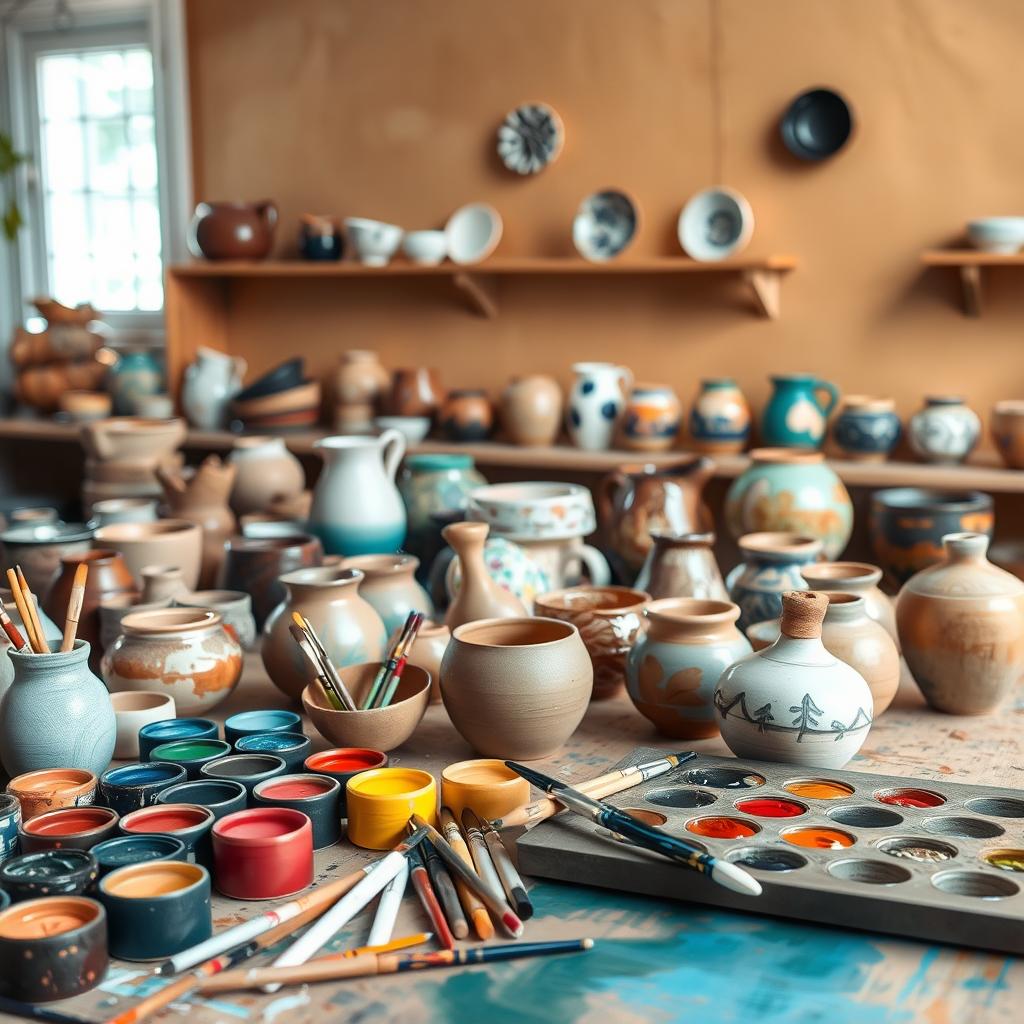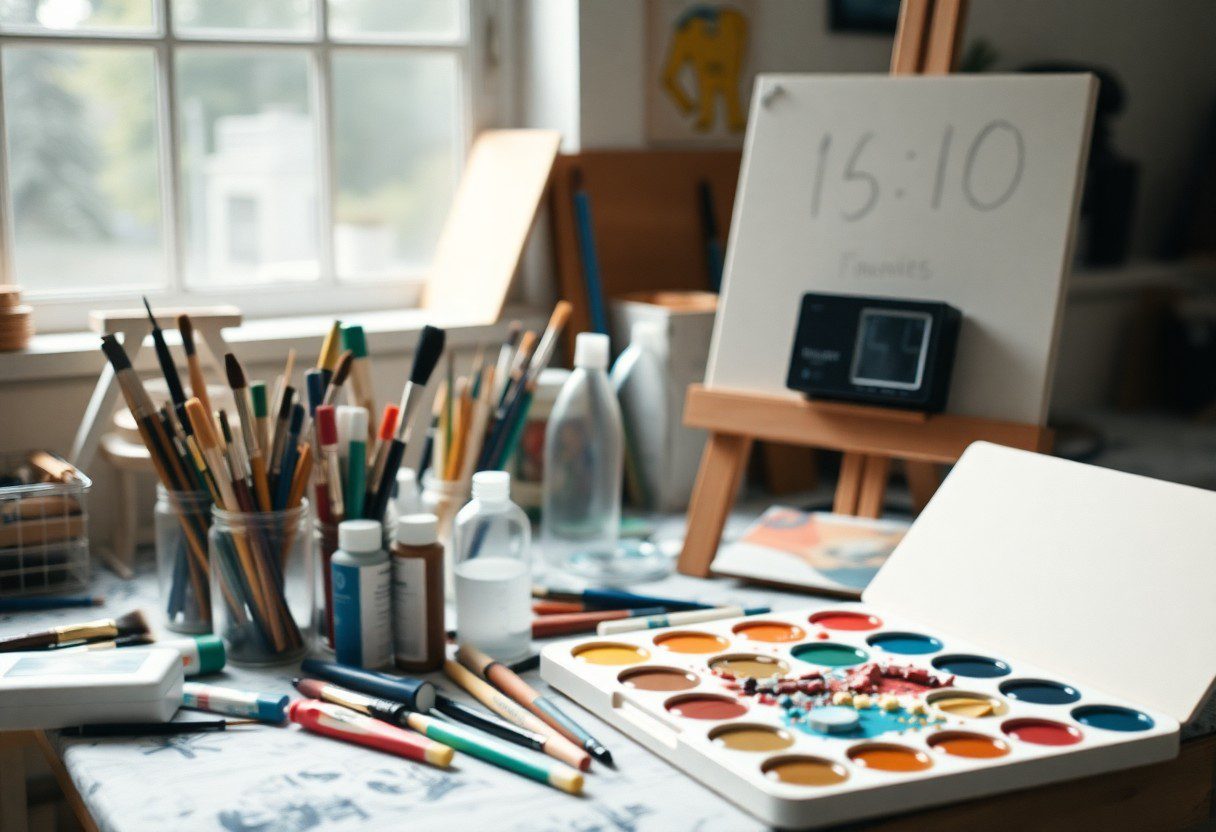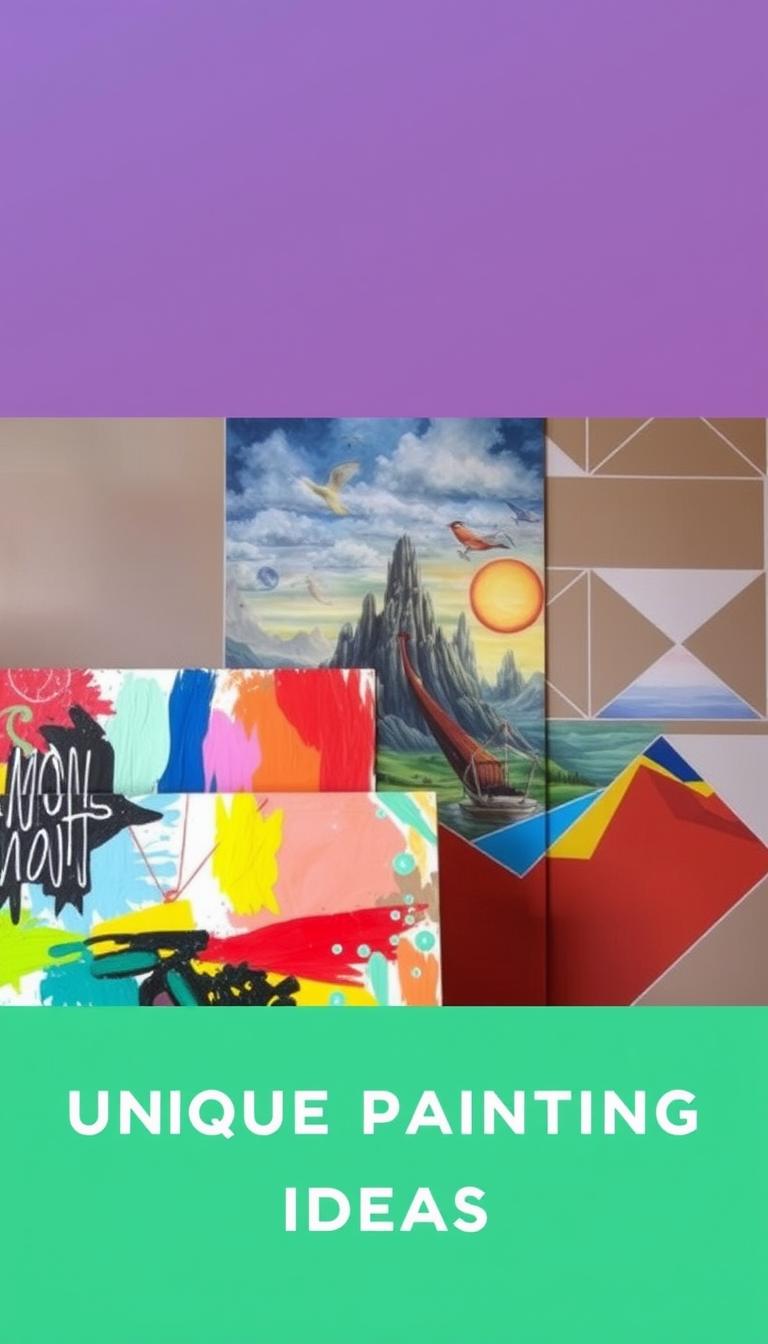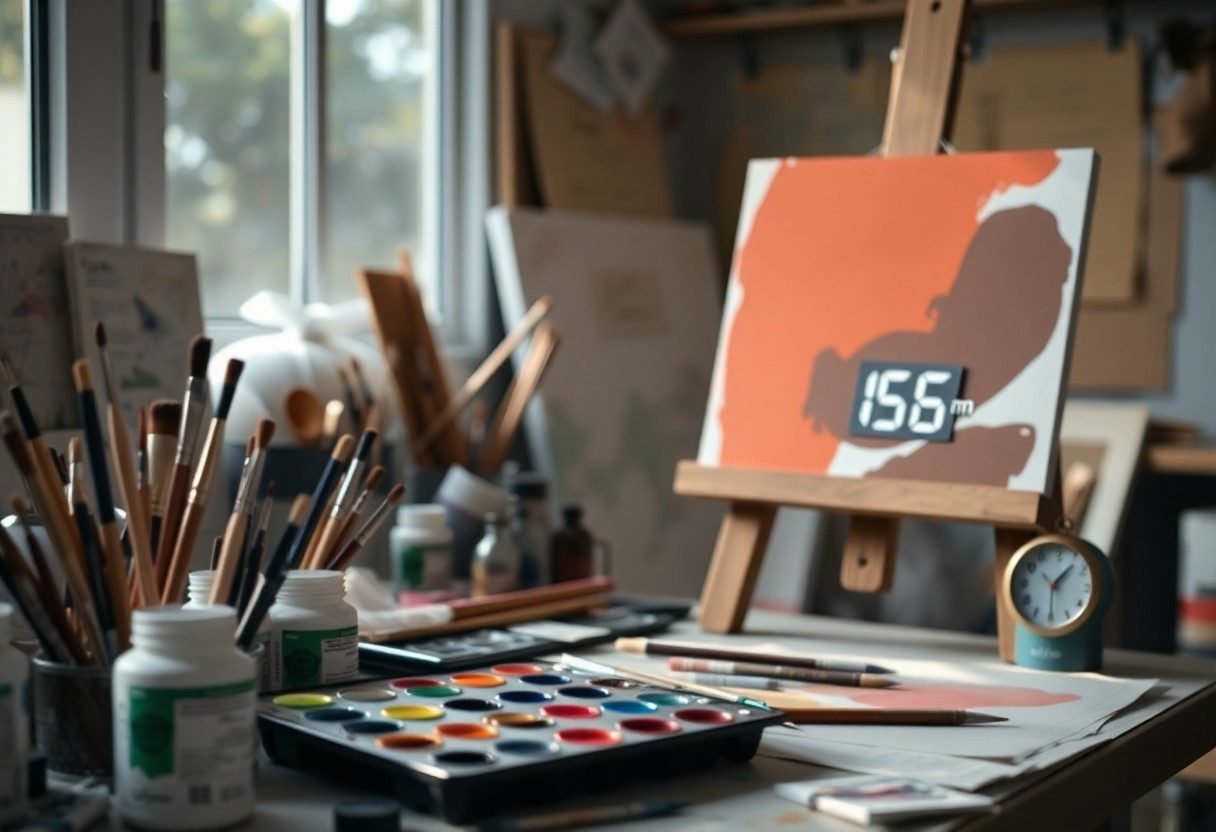Acrylic painting can be a rewarding creative outlet, but finding the time to fully immerse yourself can be challenging. In this post, you will discover crucial tips designed to help you maximize your productivity without compromising your artistic expression. By implementing these time-saving strategies, you can elevate your acrylic painting skills while fitting creativity seamlessly into your busy schedule. Let’s look into methods that can transform your artistic process and allow you to enjoy painting even on the tightest of timelines.
Essential Supplies for Quick Acrylic Painting
For busy creatives, having the right supplies can make your acrylic painting experience more productive. Essential supplies include high-quality acrylic paints, various brushes, a palette, a easel, and canvas or paper. Investing in these materials will not only save you time but also enhance the quality of your art. Organize your workspace to have everything within reach to minimize disruptions and maximize your creative flow. Thou, don’t overlook these supplies as they are key to your success.
Choosing the Right Brushes
Choosing the right brushes can significantly impact your painting efficiency. Select a few versatile brushes, such as flat, round, and liner brushes, that can handle a variety of strokes and techniques. Quality brushes will provide better control and a smoother application of paint, reducing your overall time spent on any given piece. Keep your brush sizes consistent to simplify your process and avoid unnecessary adjustments. Thou, investing in good brushes helps elevate your quick painting sessions.
Selecting Efficient Paint Types
Efficient selection of paint types accelerates your acrylic painting process. Opt for *high-quality acrylics*, which offer better coverage and quicker drying times. You may want to choose *acrylic gels* or *mediums* to enhance texture, while *liquid acrylics* can provide versatility in application. Ensure the color range you choose inspires you and lends itself to various projects without needing frequent trips to re-stock. Below is a quick guide to help you select paint types:
| Paint Type | Features |
|---|---|
| High-Quality Acrylics | Better coverage, quicker drying |
| Acrylic Gels | Enhanced texture |
| Liquid Acrylics | Versatile application |
| Heavy Body Acrylics | Thicker consistency for impact |
| Transparent Acrylics | Layering and glazing effects |
Essential paint choices to expedite your artistic process include *liquid acrylics*, *heavy body acrylics*, and *transparent acrylics*. Understand their properties and uses will allow you to optimize your time spent in creating artwork. Utilizing these types can lead to *dynamic results* with less effort. Thou, set yourself up for success with efficient paint selections.
Prepping Your Workspace for Speed
You can significantly enhance your painting efficiency by dedicating time to prep your workspace. A well-organized and clutter-free area allows you to focus solely on your creativity. Start by ensuring you have all the necessary tools and materials within reach, as this will minimize interruptions and maximize your painting time.
Organizing Your Materials
Below is a simple way to set up your materials. Group similar items together—paint tubes, brushes, and tools—within easy access. Use containers or trays to keep everything sorted, which helps you quickly grab what you need while preventing any time wasted searching through disarray.
Setting Up an Efficient Palette
Organizing your palette efficiently can drastically reduce the time spent mixing colors. It should have a consistent layout designed for your workflow. Adopt a color-coding method by placing similar hues next to each other, enabling quick access while painting. Make sure to leave space for mixing colors, as a cluttered palette can slow your progress. Utilizing disposable palettes or a sealed palette for easy cleanup can add even more speed to your process.
Time-Saving Techniques
There’s no doubt that finding efficient methods can make your acrylic painting experience more enjoyable. By incorporating smart techniques, you can maximize your creative output while minimizing time spent on each project. Adopting these strategies allows busy creatives like you to focus on what truly matters: expressing your artistic vision.
Using Large Canvases
Behind the allure of large canvases lies the promise of vast creative freedom. When you work on a larger scale, you can cover more surface area in a shorter time, enabling you to establish the foundation of your artwork swiftly. This approach not only enhances your productivity, but it also adds a dynamic quality to your pieces.
Embracing Bold Strokes
For effortless artistry, embracing bold strokes can revolutionize your approach to painting. By using sweeping and expressive brush movements, you can convey emotion and depth in your work with less effort. This technique prioritizes energy and spontaneity over intricate detail, allowing you to finish pieces more rapidly without sacrificing impact.
And as you develop your skill in bold strokes, you’ll find that this method encourages a sense of play and exploration in your creations. Experimenting with size and pressure can lead to unexpected textures and effects, enhancing the overall visual appeal of your pieces. Utilizing strong colors in conjunction with bold strokes creates a striking contrast, making your work stand out while allowing you to work quickly—vital for busy artists needing to create meaningful pieces on a tight schedule.
Speedy Sketching Methods
Once again, you can accelerate your painting process by mastering speedy sketching methods. Instead of spending hours on detailed drafts, focus on quick outlines that capture the essence of your subject. Use a pencil or charcoal to lay down simple shapes and lines, allowing you to visualize your artwork effectively before applying paint. This technique not only saves time but also boosts your confidence, enabling you to jump straight into the painting phase with clarity.
Quick Draw Techniques
By practicing quick draw techniques, you can enhance your ability to create fast sketches that convey movement and form. Set a timer for just a few minutes and challenge yourself to capture the basic elements of your subject, whether it’s a figure, an object, or a landscape. Emphasizing speed over precision encourages spontaneity and can lead to surprising discoveries in your artistic style.
Utilizing Digital Tools
By integrating digital tools into your creative process, you can significantly reduce your sketching time. You can use drawing apps or software to quickly experiment with compositions and colors, allowing you to make adjustments swiftly without the need for physical materials. This adaptability not only enhances your productivity but also gives you the freedom to explore ideas without commitment.
Understanding how to leverage digital tools can transform your sketching routine. With software that offers layers, undo options, and a variety of brushes, you can expedite your creative workflow. These features allow you to play with various concepts and compositions while easily making changes without wasting materials. Furthermore, by saving your work digitally, you can track your progress over time and revisit ideas whenever inspiration strikes. Adopting this modern approach gives you a flexible, efficient method to enhance your speed in the art-making process.
Layering Strategies for Rapid Results
Your painting process can be significantly accelerated by employing effective layering strategies. By incorporating translucent layers and utilizing quick-drying techniques, you can achieve depth and vibrancy in your artwork without the lengthy wait times. Focusing on layers not only enhances the complexity of your pieces but also allows for immediate correction and adjustments. This approach minimizes frustration and maximizes your creative flow, enabling you to produce stunning results in less time.
One-Stroke Backgrounds
An efficient way to create backgrounds is by using the one-stroke technique, which combines two or more colors on your brush. This method allows you to apply gradients and textures in one go, saving time while adding dimensionality to your work. Practice this technique to enhance your backgrounds quickly, letting you focus more on the focal points of your piece.
Fast Drying Techniques
Above all, integrating fast drying techniques can immensely streamline your painting sessions. Utilizing mediums like drying retarders or opting for heavier body acrylics can greatly reduce drying times, allowing you to layer without waiting for previous layers to set.
It’s vital to understand that proper ventilation and heat sources, such as hairdryers, can also effectively expedite drying. Be cautious when using heat, as too much can cause cracking or warping on your canvas. Additionally, using a thin application of paint can promote faster drying and facilitate smoother layering. Experimenting with different surfaces, like canvas boards or paper, can also influence drying time, helping you find the best combination to suit your busy schedule.
Multitasking While Painting
Many busy creatives can benefit from multitasking while painting to maximize productivity. You can make the most of your painting sessions by combining it with other tasks, allowing you to create art without sacrificing your busy schedule. This way, you can enjoy the therapeutic benefits of painting while still attending to other responsibilities.
Combining Projects
Along with your painting, think about incorporating other creative projects. For instance, while waiting for one layer to dry, you can sketch ideas for future pieces or even brainstorm blog topics. This strategy keeps your creative juices flowing and reduces downtime, making your overall process smoother.
Scheduling Breaks Effectively
One effective strategy for busy artists is to schedule breaks deliberately to maintain your energy and focus. This doesn’t just improve your mindset but also promotes a more productive painting experience. Ideally, you should take short breaks every hour, allowing yourself to step back and assess your work while letting your mind recharge.
Painting can be intense and requires your full attention. Taking breaks not only helps you avoid fatigue but also offers an opportunity to reflect on your painting’s progress. You might find that stepping away helps you see areas for improvement with fresh eyes. If you prioritize these pauses, you’ll maintain your motivation and bring even more depth to your art.
Conclusion
The time-saving acrylic painting tips for busy creatives can significantly enhance your productivity while maintaining the quality of your artwork. By implementing techniques such as pre-planning your color palette, using larger brushes, and focusing on a few core elements, you can create beautiful pieces in less time. Embrace the chaos of your creative schedule with these strategies, allowing you to express yourself without the stress of tight deadlines. With these tips, you’ll find that your artistic endeavors can be both fulfilling and efficient.
Q: What are some quick prep tips for starting an acrylic painting?
A: To save time, start by gathering all your supplies beforehand. Use pre-stretched canvases and organize your paints in a way that they are easily accessible. Lay out your brushes and tools so that everything is within reach. Additionally, consider using palette paper or a stay-wet palette to keep your paints workable without wasting time on mixing again.
Q: How can I speed up the drying process of acrylic paints?
A: To expedite drying, use a hair dryer on a low setting to quickly dry your layers. Thin layers of paint will dry faster than thick ones, so apply paint in layers and consider incorporating a retarder medium that slows drying time on areas where you need to blend. This can help save time as you can usually move on to the next layer sooner.
Q: What is the benefit of using acrylic paint markers for busy creatives?
A: Acrylic paint markers are a great tool for busy artists because they provide ease of use and can save significant time during the painting process. They require no brush cleaning; simply shake, prime, and paint. They are perfect for adding fine details or outlines quickly without the need for setting up additional brushes and palettes.
Q: How can I incorporate multitasking into my acrylic painting routine?
A: Multitasking can be achieved by planning your painting sessions around your daily activities. While waiting for paints to dry, engage in other creative tasks such as sketching ideas in a notebook or researching techniques online. Also consider doing paint mixing or prep work while listening to a podcast or watching educational content; this can help maximize your creative time.
Q: What strategies can I use to enhance my efficiency while painting?
A: To increase efficiency, create a schedule that allocates specific time blocks for painting, and set clear goals for each session. Focus on limiting distractions by creating a dedicated workspace. Additionally, consider working on smaller canvases or projects that can be completed in shorter time frames, allowing you to achieve satisfaction without overwhelming yourself.





